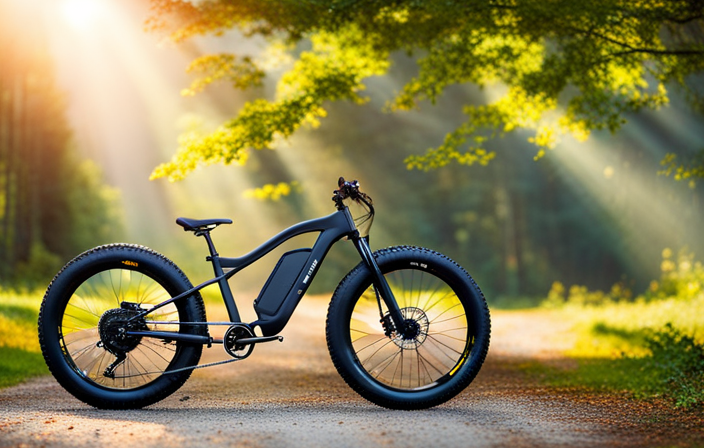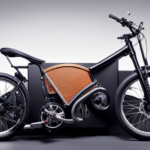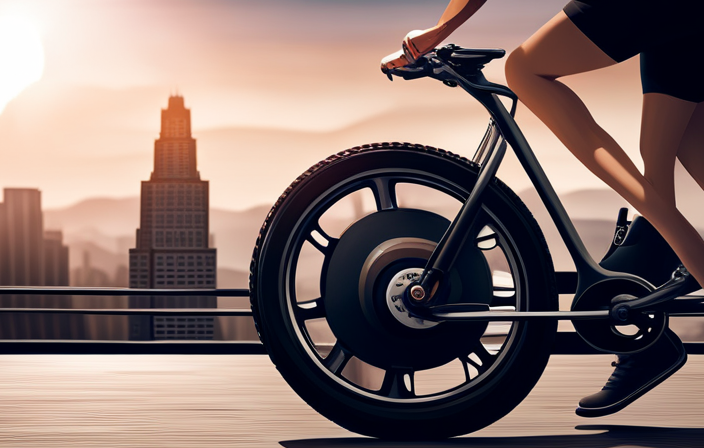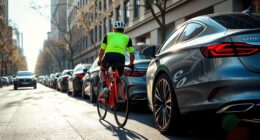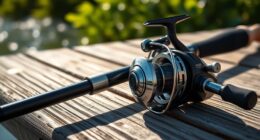As an avid cyclist, I’ve always been intrigued by the idea of converting my regular bike into an electric one. The thought of effortlessly cruising up steep hills and extending my range seemed like a dream come true.
But the burning question on my mind was, how much would it cost? In this article, we’ll delve into the world of electric bike conversions, exploring the types of conversions available, the cost of conversion kits, and the additional components needed.
So, let’s dive in and discover the electrifying possibilities of converting your bike!
Key Takeaways
- Electric bike conversion kits can range in price from $200 to over $1000, depending on the brand and features.
- Different types of conversion kits, such as front wheel, rear wheel, and mid-drive, offer different benefits and riding experiences.
- Additional components needed for electric bike conversion include a battery, charger, motor controller, throttle, and pedal assist system.
- Factors to consider when deciding between a DIY conversion and professional installation include expertise, time and effort, warranty and support, and safety considerations.
Types of Electric Bike Conversions
If you’re looking to convert your bike into an electric one, there are several types of electric bike conversions you can choose from.
One option is to use a front wheel motor kit, which is the easiest and most common type of conversion. It involves replacing your bike’s front wheel with one that has an integrated electric motor.
Another option is a rear wheel motor kit, where the motor is placed in the rear wheel hub. This type of conversion offers better traction and a more balanced feel.
Lastly, there are mid-drive motor kits, which are installed in the crankshaft area of the bike. These kits provide a more natural riding experience and better weight distribution.
Each type of conversion has its pros and cons, so it’s important to consider factors like ease of installation, performance, and cost before making a decision. Speaking of cost…
Cost of Conversion Kits
You’ll find that the cost of conversion kits can vary depending on the brand and features. When it comes to electric bike conversions, there are different types of conversion kits available in the market.
These kits typically include a motor, a battery, a controller, and other necessary components to transform your regular bike into an electric one. The prices of these kits can range from around $200 to over $1000, depending on the quality and specifications.
If you’re on a budget, there are several places where you can find affordable conversion kits. Online marketplaces like Amazon and eBay often have a wide selection of kits at competitive prices. Additionally, you can also check out specialized electric bike stores or even local classified ads for used kits at a lower cost.
Now, let’s move on to the additional components needed for your electric bike conversion.
Additional Components Needed
When it comes to converting a regular bike into an electric bike, there are a few additional components that are essential for a successful conversion.
The first component is the battery and charger, which provide the power needed to run the electric motor.
The motor controller is another crucial component that acts as the brain of the electric bike, controlling the speed and power output.
Lastly, the throttle and pedal assist system allow the rider to control the motor and choose between full electric mode or pedal assist mode.
These components work together to create a seamless and enjoyable electric biking experience.
Battery and Charger
The battery and charger are essential components of an electric bike conversion.
When it comes to the battery, two important factors to consider are its lifespan and charging time. A good quality battery can last anywhere from 2 to 5 years, depending on usage and maintenance. It’s important to choose a battery that has a long lifespan, as replacing it can be quite costly.
As for charging time, it varies depending on the battery capacity and charger specifications. Generally, it takes around 4 to 6 hours to fully charge a battery. However, some high-end chargers can charge the battery much faster, in just 2 to 3 hours.
Now, let’s move on to the next component, the motor controller, which plays a crucial role in controlling the power output of the electric bike.
Motor Controller
One important factor to consider when choosing a motor controller is its compatibility with the battery and charger. It’s essential to ensure that all components work seamlessly together for optimal performance.
The motor controller plays a crucial role in determining the efficiency of an electric bike conversion. It regulates the power flow from the battery to the motor, ensuring smooth acceleration and control. A high-quality motor controller can significantly improve the overall efficiency of your electric bike, maximizing range and minimizing energy wastage.
However, motor controllers can sometimes encounter issues. Common problems include overheating, voltage fluctuations, and motor stalling. Troubleshooting these issues may involve checking connections, adjusting settings, or replacing faulty components.
By understanding motor controller efficiency and being aware of common issues, you can ensure a smooth and reliable electric bike conversion experience.
Now, let’s dive into the fascinating world of throttle and pedal assist systems.
Throttle and Pedal Assist System
To fully utilize the throttle and pedal assist system, it’s important to understand how these components work together for a seamless riding experience. The throttle sensitivity determines how quickly the motor responds to your input, allowing you to control your speed with precision. It’s crucial to find the right balance that suits your riding style.
Additionally, the pedal assist system enhances your riding experience by providing extra power when you pedal, making it easier to conquer hills and ride for longer distances. The battery range is a key consideration when choosing an electric bike conversion kit. Make sure to choose a battery with sufficient capacity to meet your riding needs.
Now, let’s transition to the next section where we discuss the pros and cons of do-it-yourself versus professional installation.
Do-It-Yourself vs. Professional Installation
For those considering electric bike conversion, deciding between a do-it-yourself approach and professional installation can be a difficult choice. Both options have their pros and cons, but it ultimately comes down to personal preference and skill level.
Here are a few things to consider when weighing the cost and benefits of professional installation:
-
Expertise: Professional installers have extensive knowledge and experience in electric bike conversions, ensuring a high-quality and reliable result.
-
Time and Effort: DIY conversion requires research, purchasing the right components, and dedicating time to properly install and troubleshoot any issues that may arise.
-
Warranty and Support: Professional installations often come with warranties and ongoing support, giving you peace of mind.
-
Safety: Professional installers ensure that all the electrical components are properly installed, minimizing the risk of accidents or electrical malfunctions.
Transitioning to the next section, let’s now discuss the tools and skills required for a DIY conversion.
Tools and Skills Required for DIY Conversion
After weighing the pros and cons of doing a DIY electric bike conversion versus hiring a professional, I’ve decided to take matters into my own hands. The DIY conversion process allows for customization and cost savings, and with the right tools and skills, it can be a rewarding project.
To successfully convert a regular bike into an electric one, there are a few necessary tools and equipment. First and foremost, you’ll need a conversion kit that includes a motor, battery, controller, and other essential components. Additionally, you’ll require basic hand tools such as wrenches, screwdrivers, and pliers to disassemble and modify your bike. It’s also important to have electrical tools like wire cutters and crimpers for connecting the electrical components.
With these tools in hand, you’ll be well-equipped to embark on your DIY electric bike conversion journey. But before we delve further into the conversion process, let’s consider some important factors to ensure a successful outcome.
Factors to Consider Before Converting
Before diving into the process, it’s important to consider certain factors that can greatly impact the success of your DIY electric bike conversion. Evaluating these factors will help you make informed decisions and ensure that the conversion meets your needs. Let’s take a look at some key factors to consider:
| Factors to Consider | Pros | Cons |
|---|---|---|
| Budget | Cost-effective solution | May require additional funds |
| Bike compatibility | Utilize existing bike frame | Limited options for certain bikes |
| Skill level | Customize according to your abilities | Requires technical knowledge |
| Time commitment | Flexible schedule | Time-consuming process |
| Desired features | Tailor-made to your preferences | May require additional components |
Considering these factors will help you weigh the pros and cons of converting your bike into an electric one. Once you have evaluated these aspects, you can move on to the next step of finding where to buy conversion kits without compromising on quality and reliability.
Where to Buy Conversion Kits
You can easily find reliable conversion kits online or at local bike shops. When it comes to electric bike conversions, there are both pros and cons to consider.
On the positive side, converting a regular bike into an electric one allows you to enjoy the benefits of electric assistance without having to buy a completely new bike. It’s a cost-effective option that gives you the freedom to choose the bike you love and make it electric.
However, there are some downsides as well. The conversion process can be time-consuming and requires some technical knowledge. Additionally, the added weight of the motor and battery can affect the handling and maneuverability of the bike.
When it comes to popular brands, Bafang and Tongsheng are highly recommended for their reliable and high-quality conversion kits.
Transitioning into the next section about maintenance and upkeep, it’s important to note that regular maintenance is crucial to ensure the longevity and performance of your electric bike conversion.
Maintenance and Upkeep
When it comes to electric bike conversion, finding the right conversion kit is just the beginning. Once your bike is electrified, it’s important to understand the maintenance and upkeep required to keep it running smoothly. Just like any other vehicle, electric bikes require regular maintenance to ensure optimal performance and longevity.
Here are some key points to consider when it comes to maintenance and upkeep:
-
Regular cleaning: Keeping your electric bike clean not only improves its appearance but also prevents dirt and debris from damaging the components.
-
Battery care: Properly charging and storing your battery can significantly extend its lifespan.
-
Tire maintenance: Regularly checking tire pressure and inspecting for wear and tear is essential for a safe and smooth ride.
-
Scheduled maintenance: Following a maintenance schedule, which may include tasks such as lubricating the chain, adjusting brakes, and inspecting the electrical system, can help identify and address potential issues before they become major problems.
Maintaining an electric bike does require some effort, but the benefits of electric bike conversion make it all worthwhile.
Benefits of Electric Bike Conversion
When it comes to electric bike conversion, there are several key points to consider.
Firstly, the cost savings compared to buying a new electric bike are significant. Not only can you save money by converting your existing bike, but you also have the opportunity to customize it to your specific needs and preferences.
Secondly, electric bike conversion promotes environmental sustainability by reducing the reliance on fossil fuels and decreasing carbon emissions.
Lastly, the health and fitness benefits of electric bike conversion cannot be overlooked. With the added assistance of the electric motor, you can still enjoy the benefits of cycling while reducing the strain on your joints and muscles.
Cost Savings Compared to Buying a New Electric Bike
If you’re looking to save money, converting your bike to electric can be more cost-effective than purchasing a new electric bike. Not only will you be able to enjoy the benefits of an electric bike without breaking the bank, but you’ll also save money in the long run.
One of the main advantages of converting your bike is the cost of maintenance. Electric bikes generally require less maintenance compared to traditional bikes, which can save you a significant amount of money over time.
Additionally, the long-term savings are substantial. By converting your bike, you eliminate the need to buy a new electric bike, which can be quite expensive. This means that you can enjoy the benefits of electric transportation while keeping your wallet happy.
Moreover, the transition to a discussion on environmental sustainability can be seamless as electric bike conversion contributes to a greener and more sustainable future.
Environmental Sustainability
Converting your bicycle to electric not only saves you money, but also contributes to a greener and more sustainable future. By making this small change, you can have a significant impact on transportation and the environment.
Many governments around the world are recognizing the importance of electric bikes and are offering incentives to encourage their adoption. These incentives can range from tax credits to subsidies, making the conversion process even more affordable.
The increased use of electric bikes can help reduce carbon emissions and dependence on fossil fuels, leading to cleaner air and a healthier planet. As more people choose electric bikes, our cities become less congested, promoting a more efficient and sustainable transportation system.
With these government incentives and the positive impact on transportation, converting your bicycle to electric is a smart and responsible choice. And the benefits don’t stop there. Embracing electric biking also brings a multitude of health and fitness benefits.
Health and Fitness Benefits
By embracing electric biking, you’ll feel a boost in your overall fitness and enjoy improved cardiovascular health. Electric bike conversion offers numerous benefits for physical health, making it a great option for those looking to stay fit and active. Not only does it provide a fun and enjoyable way to exercise, but it also has a positive impact on your physical well-being. With an electric bike, you can easily control the level of assistance you need, allowing you to gradually increase the intensity of your workouts. This helps improve your endurance, strength, and overall cardiovascular fitness. Additionally, electric biking reduces the impact on your joints, making it a low-impact exercise option that is gentle on your body.
| Electric Bike Conversion Benefits |
|---|
| Improved cardiovascular health |
| Increased endurance |
| Enhanced strength |
| Low-impact exercise |
| Fun and enjoyable workout |
With all these benefits, electric biking is a fantastic way to improve your physical health. However, it’s important to consider the potential drawbacks and limitations of electric bike conversion.
Potential Drawbacks and Limitations
You might want to consider the potential drawbacks and limitations of electric bike conversion before making a decision.
While electric bike conversion kits offer a cost-effective way to transform your regular bike into an electric one, there are some challenges and performance limitations to take into account.
One of the potential challenges is the installation process, which can be complex and time-consuming, requiring technical knowledge and tools.
Additionally, the performance of the converted bike may not match that of a purpose-built electric bike, as the kit may not provide the same power and efficiency.
It is important to manage your expectations and understand that the converted bike may have limitations in terms of range, speed, and overall performance.
However, customer reviews and recommendations can offer valuable insights and help you make an informed decision about the right conversion kit for your needs.
Customer Reviews and Recommendations
As someone who has been researching electric bike conversions for quite some time now, I have come across numerous feedback from users who have successfully converted their bikes. The overwhelmingly positive reviews and recommendations have made me even more excited about the prospect of converting my own bike.
From improved speed and range to a smoother and more enjoyable ride, these users have experienced the true benefits of electric bike conversions. After reading through countless reviews, I have also gathered a list of highly recommended conversion kits that have consistently received praise for their quality and performance.
Feedback from Electric Bike Conversion Users
I’ve heard some positive feedback from electric bike conversion users. Customers have expressed high levels of satisfaction with the performance of their converted bikes compared to traditional bicycles. These conversions have allowed riders to enjoy the benefits of an electric bike without having to purchase a new one. To provide a clearer picture of the feedback, here is a comparison table summarizing the customer feedback on various aspects:
| Aspects | Customer Satisfaction |
|---|---|
| Speed | High |
| Range | Excellent |
| Battery Life | Long-lasting |
| Ease of Use | User-friendly |
| Performance | Superior |
| Cost-effectiveness | Great value |
Based on these reviews, it’s clear that electric bike conversions offer a satisfying riding experience with excellent performance. With such positive feedback, it’s no wonder that many riders are choosing to convert their existing bikes rather than purchasing new electric bikes. Now, let’s move on to the section about recommended conversion kits.
Recommended Conversion Kits
Looking for the best kits to convert your regular bicycle into an electric one? Check out our recommended conversion kits for a hassle-free and efficient experience.
When considering which conversion kit to choose, there are a few factors to consider before making your decision. Firstly, think about the type of motor you want. Hub motors are the most common and easiest to install, while mid-drive motors provide better balance and performance.
Next, consider the battery capacity and range. Higher capacity batteries will allow you to go longer distances without needing to recharge. Additionally, take into account the ease of installation and compatibility with your specific bicycle.
Our recommended conversion kits have been carefully selected based on their reliability, performance, and customer satisfaction.
Now that you have chosen your kit, let’s move on to the important safety considerations.
Safety Considerations
When considering electric bike conversions, it’s important to prioritize safety. Ensuring the safety of yourself and others should be the foremost concern when modifying your bike. While the cost of safety may seem daunting, it’s a small price to pay for peace of mind.
Investing in high-quality conversion kits and components will minimize the risk of accidents and malfunctions. Regular maintenance is crucial to keeping your electric bike safe. Check the brakes, tires, and electrical connections regularly to ensure everything is in optimal condition.
Additionally, always wear a helmet and follow traffic laws when riding your electric bike. By prioritizing safety, you can enjoy the benefits of electric bike conversion without compromising your well-being.
Now, let’s discuss financing options for your electric bike conversion.
Financing Options
When it comes to purchasing an electric bike conversion, there are various financing options available to make it more affordable for you. Payment plans and installment options allow you to spread out the cost over time, making it easier on your budget.
Additionally, credit programs and financing partners can provide you with flexible options and competitive interest rates, ensuring that you can find the best financing solution for your needs.
Payment Plans and Installment Options
If you’re interested in electric bike conversion, you can explore payment plans and installment options. Financing options are available to make it easier for you to convert your regular bike into an electric one. Many companies offer credit programs and financing partners to help you spread out the cost over time. With flexible payment plans, you can choose the option that best fits your budget. To give you an idea of what to expect, here is a table outlining some common payment plans and installment options:
| Payment Plan | Description |
|---|---|
| Monthly Installments | Pay a fixed amount each month for a specified period. |
| Deferred Payments | Start making payments after a certain grace period. |
| Zero Interest Financing | Enjoy interest-free payments for a set period. |
| Buy Now, Pay Later | Delay payment for a certain period, usually with no interest. |
These options allow you to convert your bike without breaking the bank. Next, let’s explore the credit programs and financing partners available to help you make your electric bike conversion a reality.
Credit Programs and Financing Partners
There are several options available to help you finance your electric bike conversion. Two options include credit programs and financing partners.
-
Credit Programs: Many electric bike retailers offer their own credit programs. These programs allow you to pay for your conversion over time. They often come with low-interest rates and flexible repayment options, making it easier for you to afford the conversion cost.
-
Financing Partners: Some electric bike conversion companies have partnerships with financing institutions. These partnerships make it even more convenient for you to obtain credit for your conversion. They may offer competitive interest rates and favorable terms, ensuring that you can comfortably repay the borrowed amount.
Another option is to explore personal loans from banks or online lenders. These loans can provide you with the funds needed to finance your conversion. You can choose a repayment plan that suits your financial situation.
Now that you know how to finance your electric bike conversion, let’s move on to the cost comparison with buying a new electric bike.
Cost Comparison with Buying a New Electric Bike
You can save a significant amount of money by converting your existing bike with an electric kit instead of buying a new electric bike. When it comes to cost comparison, the advantages of converting your bike are clear.
The cost of an electric bike conversion kit is typically much lower than the price of a brand new electric bike. Not only will you save money on the initial purchase, but you will also avoid the additional costs associated with buying a new bike, such as taxes and shipping fees.
Additionally, converting your bike allows you to keep the frame and components that you are already familiar with, saving you the hassle of adjusting to a new bike. However, there are some disadvantages to consider.
Converting your bike requires some technical knowledge and skills, and it may void any existing warranties on your bike. Overall, though, the cost savings and the ability to customize your existing bike make conversion a great option.
Conclusion and Final Thoughts
Now that we have explored the cost comparison between buying a new electric bike and converting a regular bike into an electric one, let’s draw a conclusion and discuss the pros and cons of electric bike conversion.
In my opinion, the cost of installation for an electric bike conversion kit is a worthwhile investment. Not only does it give you the opportunity to transform your current bike into an eco-friendly mode of transportation, but it also allows you to save money compared to purchasing a brand new electric bike.
To summarize the key points we have discussed, I have created a table below outlining the pros and cons of electric bike conversion:
| Pros of Electric Bike Conversion | Cons of Electric Bike Conversion |
|---|---|
| Cost-effective option | Requires some technical skills |
| Eco-friendly transportation | Limited battery range |
| Ability to customize | Potential warranty issues |
Overall, electric bike conversion offers a cost-effective and customizable solution for those who already own a bike. While it may require some technical skills and comes with certain limitations, the benefits of eco-friendly transportation and the ability to personalize your ride make it a compelling choice.
Frequently Asked Questions
Can I convert any type of bike into an electric bike?
Yes, any type of bike can be converted into an electric bike. However, there are limitations to consider, such as frame compatibility and weight distribution. Converting a bike offers benefits like increased speed, range, and eco-friendly transportation options.
Are there any limitations or drawbacks to electric bike conversion?
There are limitations to electric bike conversion, such as compatibility issues and the need for technical expertise. Safety concerns may include improper wiring and battery placement. It’s important to address these factors before attempting a conversion.
Are there any recommended maintenance or upkeep tasks for an electric bike conversion?
I highly recommend performing regular maintenance on your electric bike conversion to ensure optimal performance. This includes tasks such as checking tire pressure, cleaning the chain, inspecting the battery, and tightening any loose bolts. Keeping up with these upkeep tasks will help prolong the lifespan of your electric bike conversion and ensure a smooth and enjoyable ride.
What are some financing options available for electric bike conversion?
Electric bike conversion financing options abound! From flexible payment plans to low-interest loans, there’s a plethora of possibilities. However, it’s vital to consider the pros and cons of financing, ensuring it aligns with your financial goals.
How does the cost of converting a bike compare to buying a new electric bike?
Converting a bike to electric can be a cost-effective option compared to buying a new electric bike. Not only does it save money, but it also allows you to customize your existing bike and enjoy the benefits of electric biking.
Conclusion
In conclusion, converting a regular bike into an electric bike can be a cost-effective and rewarding option for those looking to enjoy the benefits of electric transportation without breaking the bank.
While some may argue that buying a new electric bike would be a better choice, the truth is that conversion kits offer a more affordable alternative. By investing in a conversion kit and a few additional components, you can transform your bike into an electric powerhouse and experience the joy of effortless riding.
Don’t let cost be a barrier to enjoying the many advantages of electric bike conversion. Start your conversion journey today and embrace a greener and more efficient way of commuting.

